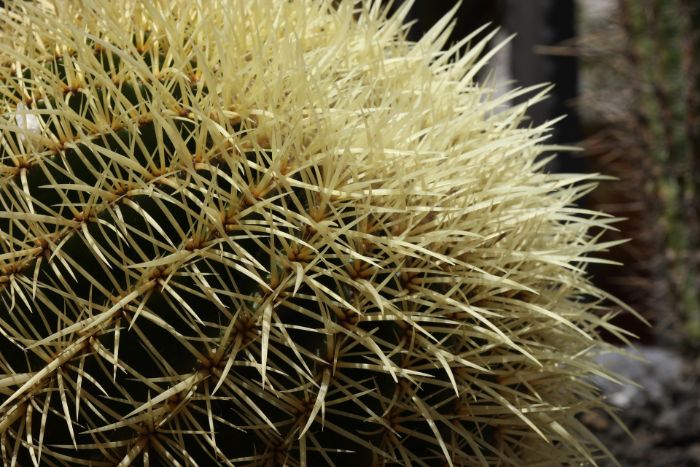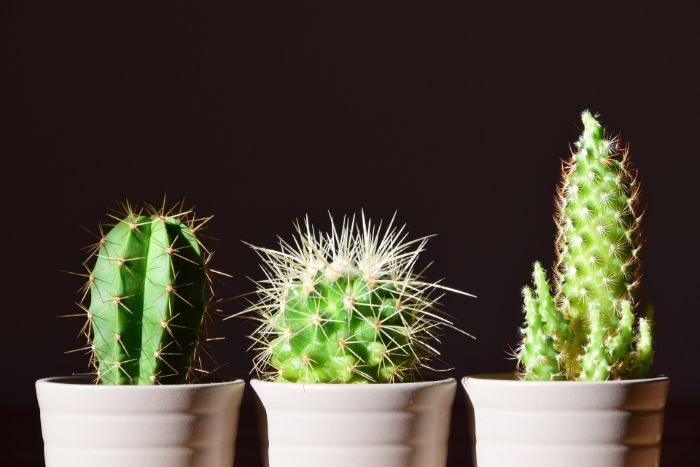I always assumed that cacti just had spines for protection, but it turns out they have many more functions and are really quite remarkable adaptations. They help cacti overcome the difficulties of living in desert conditions in a variety of interesting ways.
Why do cacti have spines? Spines help cacti to thrive in desert environments by providing multiple functions. They protect the plant from predators, provide shade, help regulate temperature, reduce water loss and even help the plant to spread and reproduce.
Read on and I’ll explain exactly how cacti use their spines to help them to survive and thrive in the inhospitable conditions in which they live.
Why Do Cacti Have Spines?
There are 6 main reasons why cacti have spines. I’m going to explain each reason in a little detail and I’m sure you’ll be fascinated by the interesting uses for these spiky adaptations.
1. Cactus Spines Trap Air, Regulating The Plant’s Temperature
Although cactus spines are small, they are often very numerous, covering the surface of the plant. In the same way as wearing a jumper traps an insulating layer of air next to your skin, the spines of a cactus trap a layer of air close to the surface of the plant, reducing ventilation.
This layer of air insulates the cactus and prevents large swings in temperature. This is useful both in the very hot conditions of the desert, but also protects them from large changes in temperature between day and night, and during the different seasons, where in some desert climates, it can get quite cold at night.
2. Provide Shade

Cactus spines are small and thin and not what you would normally expect from a sun shade. Hold a single cactus spine up and the shadow that it makes is tiny and seemingly insignificant.
However, because cacti spines are so numerous, the combined effect of all of them provides a surprising amount of shade. There aren’t too many places to find shade in a desert and the sun could easily damage a cactus without some ability to prevent some of this reaching the surface of the cactus.
In addition to reducing heat, the shade of cactus spines also reduces evaporation of water from the surface of a cactus, reducing water loss and helping a cactus survive more efficiently through a period of drought.
3. Spines Protect Cacti From Predators
Cactus spines are extremely sharp and can be very painful to touch unless you are careful. I’m constantly surprised by how sharp they are when I am repotting a cactus, and it reminds me why special care is needed around these plants.
Cacti are often one of the most numerous plants in a desert environment and, for the many animals that live here, a cactus would make a welcome meal, but the spines prevent the majority of animals from feasting on these plants.
Unfortunately for cacti, there are a number of animals that aren’t bothered in the slightest by the sharp spines of cacti, and go ahead and eat them anyway. Javelinas, camels and many rodents and insects will all eat cacti despite their spines.
4. Mobility And Reproduction
Some species of cactus have barbed spines which readily attach to any animals (or even humans) that get too close to them. This is a clever reproductive mechanism, most famously exhibited by Cholla (Cylindropuntia) cactuses.
When anything gets to close, the barbed spines will stick in the fur or skin of the animal. Part of the cactus will detach from the parent plant and be transported elsewhere.
When these parts of the cactus eventually detach from the animal, they will start growing a new plant where they fall.
This behavior isn’t unique to cacti, as many plants enlist the help of animals to help them reproduce and spread, but some cacti have assigned this role to their spines, with excellent results.
Interestingly, this means that when you see hundreds of Cholla cacti in the desert, they are likely to be clones of each other and genetically identical, due to the efficiency of this reproductive technique.
5. Cactus Spines Help Collect Water
The deserts that many cacti live in are notoriously arid and rainfall is unpredictable. It can be a long time before the next rain, so cacti and other desert plants must make use of adaptations to collect, store and conserve water.
Cactus spines have an important role in collecting water from the air and are able to do this very efficiently due to the large surface area in contact with the air.
Cacti don’t lose water from these spines as they are metabolically inactive, but they allow water vapor from the air to condense onto the spines and run down onto the surface of the plant and into the soil, to be absorbed by the roots.
Even when it has not rained for a long time, there can still be significant moisture carried in the air. Warm air holds more moisture, but as it cools, the air can’t carry all of the moisture, and some of this will condense onto surfaces. This is why dew forms in the evening, and cacti are ready and waiting to collect this source of water from the air.
6. Cactus Spines Are Modified Leaves
Cactus spines are actually heavily modified leaves, although they don’t have any of the same structures that are found in normal leaves and are completely inert. Cacti have adapted to the harsh conditions they live in by developing areoles instead of branches and spines instead of leaves.
The problem with leaves is that the large surface area causes a lot of water to be lost in a process called transpiration. Cacti have adapted by moving the functions of leaves into the body of the cactus. This means that photosynthesis is done in the trunk of the cactus, rather than where we normally think of it being done in other plants.
The adaptation and development of spines developed gradually, as the hot and inhospitable conditions of deserts led to survival advantages in having smaller leaves. Gradually, the functions of the leaves moved to the central stem, and the leaf remnants hardened and developed the other adaptations of spines that we see today.
What’s The Difference Between Thorns And Spines?
Plenty of plants have thorns, but only a few types of plants have spines, and yet a lot of the time they look quite similar. So what’s the difference? Spines are modified leaves, whereas thorns are modified branches.
All plants with thorns will also have leaves of some description. Plants with spines have no leaves, because the spines ARE the leaves.
Interestingly, many of the plants we characteristically associate with having thorns, actually don’t. The thorns of roses are actually prickles. Prickles are sharp extensions of the stem or leaf epidermis and are different from both spines and thorns.
Are Cactus Spines Poisonous?
Cactus spines are not poisonous. They can, however, cause significant damage to your skin, particularly those varieties with barbed spines. Barbed spines are designed to detach and lodge in the skin of the animal or human they come into contact with. These spines are difficult to remove and can cause localized dermatitis or a granulomatous reaction if they are left untreated.
Opuntia cacti have very short spines which will lodge in your skin and can be really difficult to get out. They will irritate the skin and be very uncomfortable. I’ve spent many frustrating hours trying to get prickly pear spines out of my skin with a pair of tweezers. Not a situation I would like to be in again.

Do Cactus Spines Grow Back?
Cactus spines emerge from areoles as the plant grows. Mature spines are inert and will not grow back if they are damaged or removed. New spines will only grow from new areoles as the cactus grows.
If you are growing cacti as ornamental plants, handle them with care, as the cosmetic damage that is done from damaging or breaking spines is permanent.
I hope you’ve enjoyed learning why cacti have spines. This article is part of a series looking at some of the interesting characteristics of cacti and succulents. Check out some of the other articles in this series below.

